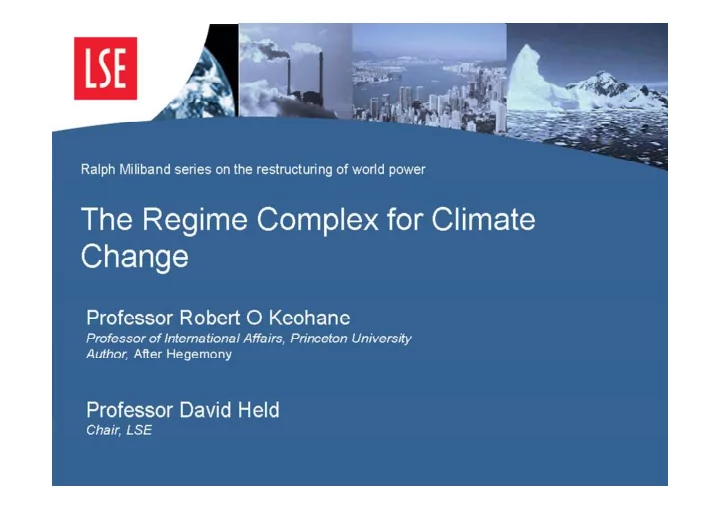

Ralph Miliband series on the restructuring of world power The Regime Complex for Climate Change Professor Robert O Keohane Professor of International Affairs, Princeton University Author, After Hegemony Professor David Held Chair, LSE
The Regime Complex for Climate Change Ralph Miliband Lecture, LSE, November 8, 2010 Robert O. Keohane
The Regime Continuum
The Regime Complex for Climate Change Expert Assessments UN Legal Regimes (IPCC; national assessments) (UNFCCC & Kyoto Protocol; funding mechanisms [GEF]; and political Adaptation Initiatives agreements [e.g., Copenhagen Accord]) (e.g., programs by FAO and other UN agencies; MDB adaptation funding) Montreal Protocol Bilateral Initiatives (regulation of ozone-depleting gases Clubs that also affect climate warming) (e.g., Norway-Indonesia; US-India; UK-China) (e.g., MEF, APP, G20, G8, G8+5) Subnational Action Multilateral Development Assistance (e.g., California’s emission (e.g., “mainstreaming” climate at MDBs; World Bank PCF, trading system w/int’l offsets; Forestry and Adaptation funds) subnational procurement rules) Geoengineering Governance Nuclear Suppliers Group (e.g., ocean dumping rules for iron Financial Market Oversight (e.g., rules to accommodate US-India fertilization; ENMOD convention; possible nuclear partnership) (e.g., possible rules on cross-border regulation under CBD or new treaties) emission trading) IPR; BITs and other Investment Regulation GATT/WTO (e.g., possible incentives to deploy new technology) (e.g., possible rules to accommodate border tariff adjustments)
Problem Diversity: Four Distinct Cooperation Problems • Coordination of emission regulations • Compensation – financial transfers • Adaptation – including possibly geo- engineering • Stimulating innovation despite difficulties of commercialization due to public goods issues.
The Key Political Problem • Costs are immediate. • Benefits are uncertain and in the future.
Salient Features of Climate Change Problem • Divergence of Interests • Pervasive Uncertainty • Difficulty in making linkages (compared to trade, for instance) Also, interests, uncertainty, and linkages are themselves changing quickly.
The Clean Development Mechanism: negative and positive aspects CDM: Designed to engage developing countries. But perhaps 2/3 of CDM credits have not represented genuine reductions. Change difficult due to the nature of the UN process: multiple vetoes. However, CDM has generated useful experience for offsets.
Advantages of regime complexes : • Flexibility • Adaptability
What a Regime Complex Could Do • Facilitate emissions trading • Innovate around land use and forestry (REDD: Reducing Emissions from Deforestation and Forest Degradation) • Devise sensible Border Tax Adjustments • Foster Innovation Clubs.
Conclusions • Regime complexes are not ideal -- an optimal comprehensive regime would be better – but they are the best we can do under present political circumstances. • We should “make the best of a bad situation.” • Regime complexes have advantages: notably flexibility and adaptability. • The UNFCCC would play an umbrella role, but not be central to the process as it has been.
Ralph Miliband series on the restructuring of world power The Regime Complex for Climate Change Professor Robert O Keohane Professor of International Affairs, Princeton University Author, After Hegemony Professor David Held Chair, LSE
Recommend
More recommend